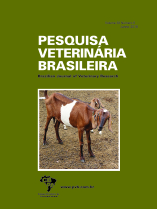 |
|
|
|
Year 2018 - Volume 38, Number 6
|

|
Epidemiology of mycoses, pitiosis and micotoxicosis in horses in southeastern Rio Grande do Sul, Brazil, 38(6):1110-1116
|
ABSTRACT.- Reis-Gomes A., Marcolongo-Pereira C., Sallis E.S.V., Bruhn F.R.P., Faria R.O., Schild A.L. & Meireles M.C.A. 2018. [Epidemiology of mycoses, pitiosis and micotoxicosis in horses in southeastern Rio Grande do Sul, Brazil.] Epidemiologia das micoses, pitiose e micotoxicoses em equinos no sudeste do Rio Grande do Sul. Pesquisa Veterinária Brasileira 38(6):1110-1116. Laboratório Regional de Diagnóstico, Faculdade de Veterinária, Universidade Federal de Pelotas, Campus Universitário, Capão do Leão, RS 96010-900, Brazil. E-mail: angelitagomes@gmail.com
The epidemiological aspects of diseases caused by fungi and oomycetes in horses in southeastern Rio Grande do Sul, Brazil, is described. The epidemiological rates, their causes, and health importance in the region were established. A descriptive epidemiology study was carried out in relation of potential risk factors. The impact on these diseases in the region was measured. From 1978 to 2014, pythiosis had a prevalence of 49.71% (86/173), and mycotoxicoses of 30.05% (52/173), with 45 cases of leukoencephalomalacia and 7 of ergotism. The prevalence of fungal infections was 19.65% (34/173) of cases. Dermatophytosis was the most prevalent fungal infection with 58.82% (20/34) of cases. The most isolated dermatophyte species were Trichophyton mentagrophytes 60% (12/20), Trichophyton equinum 25% (5/20) and Microsporum gypseum, Microsporum canis, and Trichophyton verrucosum, both responsible for 5% (1/20) of infections. Rhinosporidose was diagnosed in 35.29% (12/34) of cases. Uterine mycosis caused by Candida albicans and Cryptococcus laurentii was observed at 5.88% (2/34) of cases. Cladosporium sp. allergy was noted in one record. According to the incidence from 1990 to 2014, pythiosis had median incidence (MI) of 2.98 and interquartile range (DI) of 3.82. Mares were 4.18 times likely to develop the disease then males. The disease occurs in the region in every season. Leukoencephalomalacia had MI of 0.0; DI 1.00 and male horses were 3.4 times more likely than mares to develop the disease. Leukoencephalomalacia was 6 times more likely to occur during winter. Ergotism had MI of 0.00; DI of 0.000, rhinosporidiosis MI of 0.00, DI of 0.088 and ringworm MI of 0.00, and DI of 0.935. In the study pythiosis had the highest prevalence among the diseases observed, and may be considered endemic in the region. The magnitude of the diseases observed may be even greater within the equine herd, since these diseases are not of obligatory notification and some are well known by veterinarians and owners, who often do not obtain a laboratory confirmation of the diagnosis. |
| |
|
|
| |
|
 |